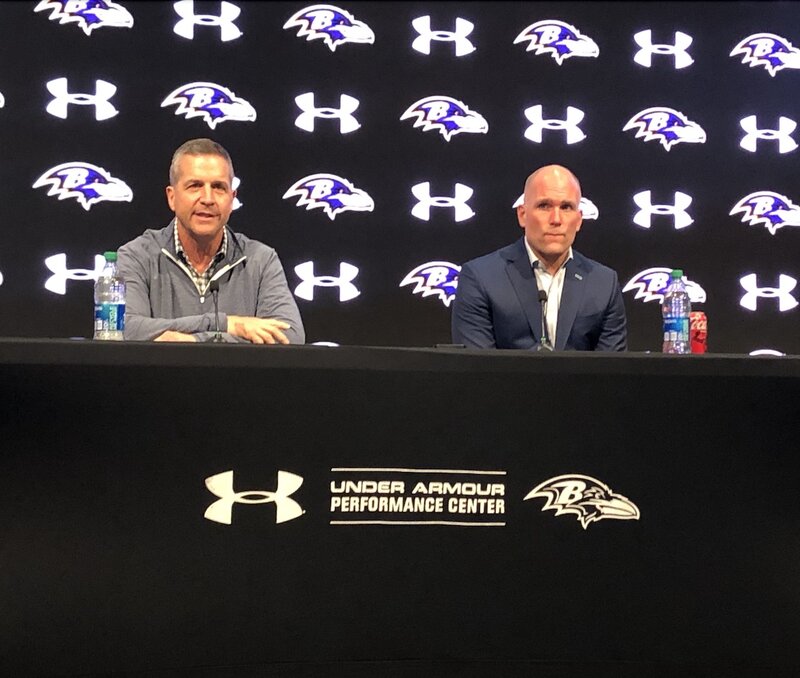On November 22, 2002, Modell finally and formally named Ozzie Newsome the General Manager of the Baltimore Ravens, no small feat for a kid from Muscle Shoals who remembers his life and childhood that lacked dignity and equal opportunity to people of his color in the Deep South. The truth is that he’d really been the general manager the entire time, but it’s not like Newsome was one to ever care about his official title.
It’s impossible to chat with a current or former Baltimore Ravens scout who doesn’t repeat the same phrase about Newsome: “He lets us do our job.” Several also alluded to the way Newsome not only manages their strengths and expertise, but also attempts to improve their weaknesses.’’
“He doesn’t poke and he lets your quality shine,” said longtime partner and current assistant general manager Eric DeCosta. “We look at ourselves as a family. Everything about the way Ozzie has managed it has been about the team. How can we make the Baltimore Ravens better?”
All you to need to do is look at the continuity of the 13 scouts on his staff and realize there have only been five jobs that have changed hands in 17 years and two of the departures came when Phil Savage and later George Kokinis both left at different points to become the general manager of the Cleveland Browns. Kokinis actually retreated rather quickly, returning to the Ravens as a senior personnel assistant after a dreadful 2009 year in Cleveland. Savage, who was a long-time right hand man for Newsome, wound up scouting briefly for the Philadelphia Eagles and now runs the Senior Bowl in his hometown of Mobile, Alabama.
It was Savage, along with Newsome, who helped build the way the Ravens scout and draft football players, which has become the hallmark of Newsome’s tenure as the leader of the Ravens’ player personnel team.
“On draft day, Ozzie has this Russell Crowe kind of ‘A Beautiful Mind’ thing going on with processing information like a savant or a mathematician does,” said Brian Billick. “Ozzie has absorbed all of this information and weighed everything and all of it is borne of all of the collective experience you only get from actually being involved in it all of your life.”
When Newsome, Marchibroda, and Savage convened in late February 1996, they were already relatively far along in the scouting and draft process despite the toll the move from Cleveland to Baltimore took on everyone involved who came with the franchise. Marchibroda was coming from Indianapolis, where he wasn’t welcomed back by the Irsay family after almost taking a mediocre team to the Super Bowl.
It seemed only natural that the personnel men, who were also new to running what had been a Bill Belichick and Mike Lombardi football production up until the revolt of the Dawg Pound, would get together and discuss what their needs were in the draft. And, for the most part, they were trying to establish some kind of foundational principles and ideology in how the new Baltimore Ravens franchise would draft players and evaluate and select talent. David Modell was becoming very influential in the franchise and he loved lists with written goals and objectives throughout the organization, which he was attempting to shape on the business side with a fresh start and some people and concepts in Baltimore.
Essentially, Newsome and Savage asked Marchibroda what kind of football players he wanted to coach so that their picks would match his system. Marchibroda, who had just turned 65 and like Newsome was a pretty good player himself as a first-round, No. 5 overall selection as a quarterback from St. Bonaventure by the Pittsburgh Steelers in 1953, had seen a lifetime of football and began his coaching career in 1972. The Ravens were his eighth and final stop and he had a world of knowledge of what worked in the NFL.
Marchibroda is widely credited as the original architect of the hurry-up, no-huddle offense, which has become a staple of modern NFL football, and was a mentor to Hall of Famer Jim Kelly while serving as the quarterbacks coach and offensive coordinator of Marv Levy’s Buffalo Bills teams that went to four Super Bowls.
In early 1996, Marchibroda became the first one to define what it means to “play like a Raven.” The phrase that the professorial Marchibroda liked the best was “football temperament.” Webster’s define the word “temperament” as: a person’s or animal’s behavior, esp. as it permanently affects their behavior. So to some degree, temperament means that it’s instinctive and inherent.
It meant a guy who likes the weight room, who loves the offseason program, who likes being in good shape, and being physical on the field. Marchibroda didn’t want the biggest and strongest guys who didn’t really like football. If you didn’t love football, he reasoned, you weren’t ever going to be great football player.
Marchibroda was dedicated to teaching football. He wanted students – or in this case, players – who wanted to be obsessed with football like he was for over 50 years of his life.
“Ted had a sign over the door in the locker room that said, “WHY NOT US?” said Pat Hill, who is now the tight ends coach for the Atlanta Falcons. “Nobody expected us to do much, and Ted was a heckuva leader. He helped build the foundation of that whole program. He was a perfect bridge for the Modells. He’d been through it all and was a very wise man. He brought a lot to a franchise going through a tough time. He was a sturdy leader and had great skills. It wasn’t just his age – it was his great wisdom.”
And that blended well with Newsome’s ability to get to know these kids – like Jonathan Ogden and Ray Lewis, who the Ravens would select less than seven weeks after he, Marchibroda and Savage met and made their initial desires known for the future of the franchise.





























